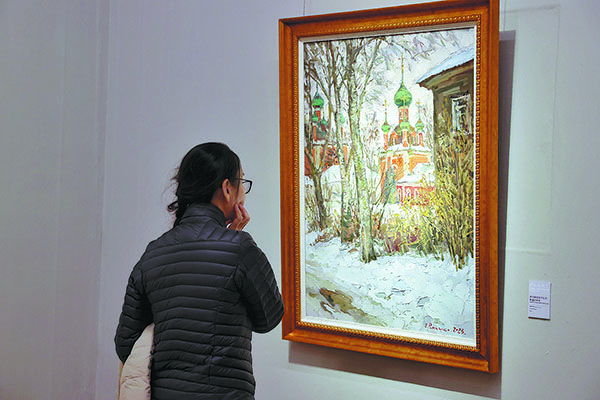

Visitors who enter the No 5 hall of the National Art Museum of China will be greeted by a series of oil landscapes showing tranquil water town views in Shaoxing, East China's Zhejiang province. They may be surprised to find that the works, capturing the poetic mood and sense of Eastern aesthetics, are not created domestically, but by Evgeny Romashko, a celebrated Russian artist.
The series, A Bath in the Shared Sunlight, opens a journey of elegance and serenity, portrayed with a vibrant palette, across China and his homeland, at the exhibition that runs until Tuesday.
With more than 50 landscapes, the exhibition highlights Romashko's career, which spans decades and inherits the technical and aesthetic traditions of Russian art. It shows how he has utilized that accumulation of depth to portray the landscapes of a different country, while being able to transmit the spirit of Chinese culture.
Wu Weishan, director of the National Art Museum of China, says that Romashko travels through the extensive fields of his homeland, nurtured by its long, rich history, and explores its eternal beauty.
In his landscapes, Romashko displays a varying, panoramic view of his home country, from the sound of bells ringing from a centuries-old monastery to the expansive green fields adorned with blooming camellias in the city of Tver, and the bustling streets of vehicles and passersby in Moscow.
"Meanwhile, he has for years traveled to China and created artworks here," Wu adds. "His trips have taken him to the grasslands of the Inner Mongolia autonomous region, to coastal cities such as Dalian, in Liaoning province, and to the picturesque waterside streets of Shaoxing, introducing him to the varied views of China, which has become his second home."
He says Romashko is passionate about sketching outdoors and his work is grounded in structural beauty, a balanced composition and an arrangement of colorful nuance.
"A dense, poetic atmosphere is the hallmark of Romashko's paintings, in which his subjects are often gently kissed by the sunlight, no matter what season is being portrayed," Wu says.
Romashko says: "Art is like the sun. It brings warmth and hope to people, amid challenges, and it binds people together."
He donated some of the works on show to the National Art Museum of China at the exhibition, which opened on Friday.
The art museum holds a rich collection of Russian oil paintings and sculptures, which are popular among domestic visitors.
Over the years, the museum has mounted exhibitions and organized cultural dialogue with Russian artists, including Zurab Tsereteli, who donated his works, sculptures and prints to the art museum at More Than Life, an exhibition of his work shown in September, and Valery Lednev, deemed the People's Artist of the Russian Federation, who gave a master class in July and donated two paintings on the occasion of the 60th anniversary of the museum.